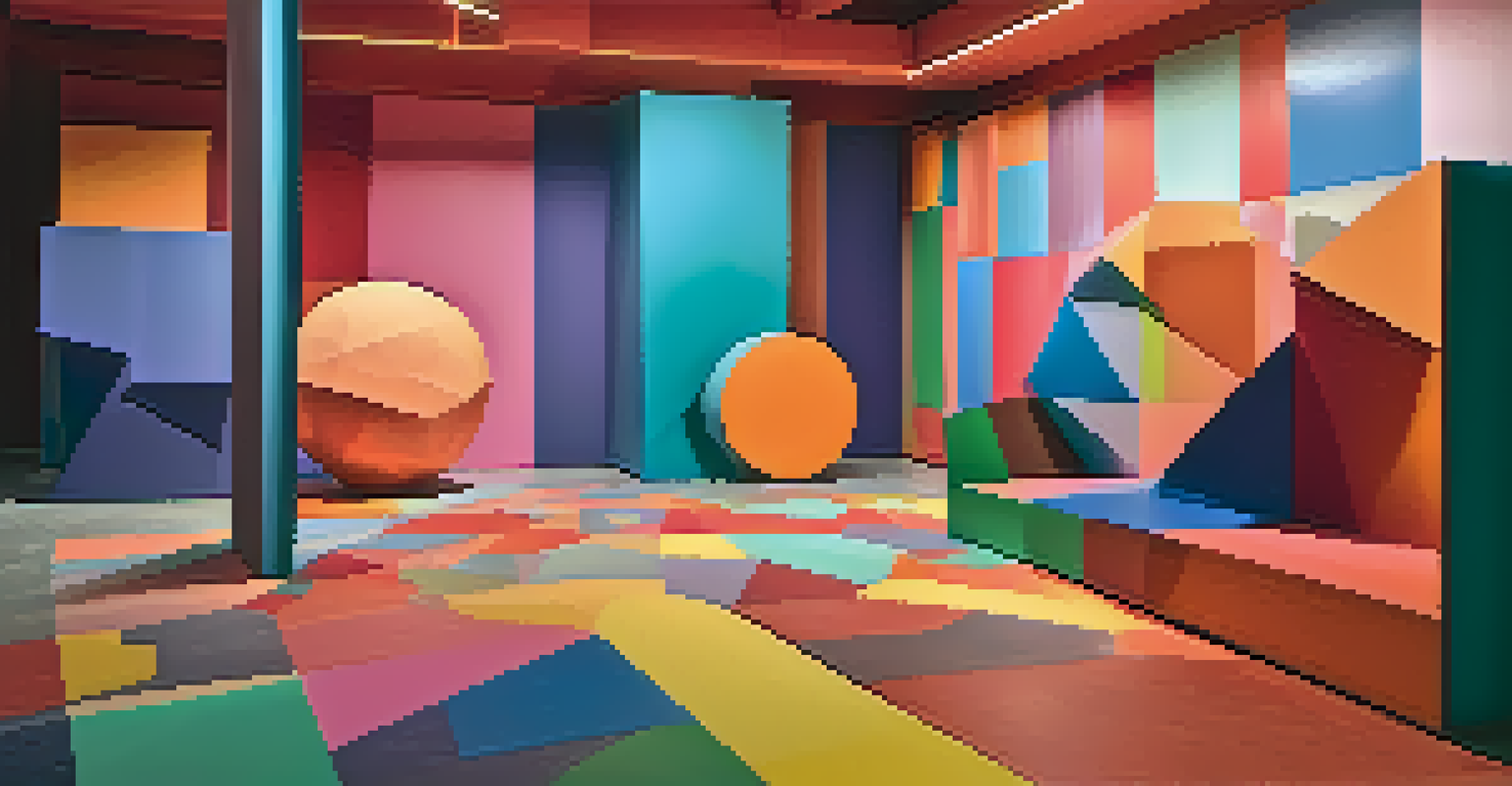The Role of Color Psychology in Contemporary Painting Trends

Understanding Color Psychology and Its Importance
Color psychology is the study of how colors influence emotions and behaviors. This field plays a significant role in contemporary art, where artists carefully choose colors to convey messages and evoke feelings. For example, warm colors like reds and oranges can elicit excitement or passion, while cooler blues and greens often promote calmness and tranquility.
Color is the keyboard, the eyes are the harmonies, the soul is the piano with many strings.
In contemporary painting, artists leverage these psychological effects to connect with their audience on a deeper level. By understanding the emotional impact of color, they create works that resonate with viewers, drawing them into the narrative behind the artwork. This connection is essential in a world where art competes for attention across various platforms.
As society evolves, so do the associations we have with colors. Contemporary artists are not only aware of traditional meanings but also how cultural shifts can alter perceptions. This awareness allows them to innovate and push boundaries, ensuring their work remains relevant and impactful.
The Influence of Trends on Color Choices
Contemporary painting trends are often shaped by broader societal movements, including fashion, technology, and even politics. As these trends evolve, so do the color palettes artists choose to reflect them. For instance, the rise of eco-consciousness has led to an increase in the use of earthy tones and natural hues in modern artworks.

Art movements such as minimalism and abstract expressionism also influence color trends. Artists embracing these styles often utilize a limited color palette to focus on form and texture, allowing the chosen colors to carry more weight. This can create a powerful visual statement that encourages viewers to consider the deeper meanings behind the simplicity.
Color Influences Emotions Deeply
Colors play a crucial role in evoking emotions and shaping the viewer's experience in contemporary art.
Moreover, social media platforms like Instagram and Pinterest have democratized the sharing of artistic inspiration. Artists are now influenced not only by historical movements but also by what is trending online. This has resulted in vibrant, bold color choices that capture attention and invite interaction from a global audience.
Cultural Context and Color Perception
Color perception is not universal; it varies significantly across cultures and contexts. For example, while white is often associated with purity and weddings in Western cultures, it can symbolize mourning in some Eastern cultures. Understanding these nuances allows contemporary artists to create work that speaks authentically to specific audiences or comments on cultural dialogues.
Colors, like features, follow the changes of the emotions.
Artists today often blend cultural influences within their work, using color to navigate complex narratives. This blending can lead to vibrant, multicultural representations that resonate with diverse audiences. For instance, an artist might use a combination of bold reds and golds to reflect both Western and Eastern traditions, creating a dialogue between cultures.
By being mindful of cultural color meanings, artists can foster deeper connections with their work. This approach not only enriches the viewer's experience but also challenges preconceived notions about color and its significance in art.
Emotional Responses to Color in Art
One of the most captivating aspects of color in contemporary painting is its ability to evoke strong emotional responses. Artists harness this power to create a specific mood or atmosphere in their work. For example, a canvas dominated by dark blues and blacks might evoke feelings of sadness or introspection, while vibrant yellows and pinks can inspire joy and energy.
This emotional impact is often intentional, as artists aim to create a particular experience for their viewers. They might use contrasting colors to provoke tension or harmony, guiding the viewer's emotional journey through the artwork. This layered emotionality is what makes contemporary painting both compelling and thought-provoking.
Cultural Context Shapes Color Meaning
Understanding cultural differences in color perception allows artists to create works that resonate more authentically with diverse audiences.
Moreover, the viewer's personal experiences and memories can influence how they interpret colors in art. A color that brings happiness to one person may evoke sadness in another, creating a unique connection to the artwork. This subjectivity adds an additional layer of richness to contemporary painting, highlighting the interplay between the artist's intention and the viewer's perception.
Case Studies of Color in Contemporary Artists' Work
Numerous contemporary artists have successfully employed color psychology to enhance their work. Take, for instance, the vibrant palettes of Yayoi Kusama, whose use of bold colors and repetitive patterns creates an immersive experience for viewers. Her work often embodies themes of infinity and self-obliteration, where color plays a crucial role in conveying her unique perspective.
Another example is Mark Rothko, known for his large, emotive color fields that evoke deep feelings. Rothko's choice of colors—often contrasting yet harmonious—was deliberate, aimed at eliciting a visceral reaction from the viewer. His work invites contemplation and introspection, showcasing the profound impact that color can have in contemporary painting.
These case studies reveal how contemporary artists not only understand color's psychological effects but also actively engage with them to create meaningful artworks. By examining their choices, we can appreciate the role of color in shaping both the artistic narrative and the viewer's experience.
The Role of Technology in Color Application
In the digital age, technology has dramatically transformed how artists approach color in their work. Digital tools allow for precise color selection and experimentation, giving artists the freedom to explore a vast array of hues and shades. Programs like Adobe Photoshop enable artists to visualize their ideas before committing to a physical medium, fostering creativity and innovation.
Moreover, technology has made it easier for artists to reach wider audiences through online platforms. Color trends can spread rapidly, influencing artists around the globe. This interconnectedness encourages the sharing of ideas and techniques, allowing for a dynamic evolution of contemporary painting styles that incorporate diverse color palettes.
Technology Transforms Color Application
Digital tools and platforms have revolutionized how artists explore and apply color, fostering creativity and broadening their reach.
As artists embrace these technological advancements, they continue to push the boundaries of color application. Whether through traditional mediums or digital canvases, the role of color remains a vital aspect of contemporary art, reflecting both the artist's vision and the current cultural landscape.
Future Trends in Color Psychology and Art
Looking ahead, the intersection of color psychology and contemporary painting is likely to evolve further. As artists continue to experiment and respond to societal changes, we can expect to see new color trends emerge that challenge traditional perceptions. For instance, the increasing focus on mental health may lead to more calming color palettes aimed at promoting well-being.
Additionally, the rise of virtual and augmented reality in art could redefine how color is experienced. Artists may start to explore immersive environments where color plays a dynamic role, creating interactive experiences that engage viewers on multiple sensory levels. This could open up exciting avenues for exploring the emotional impact of color in entirely new ways.

Ultimately, the future of color psychology in contemporary painting will reflect the complexities of our world. As artists remain attuned to the emotional and cultural significance of color, they will continue to create meaningful works that resonate with their audiences, ensuring that the role of color remains as vital as ever in the art landscape.